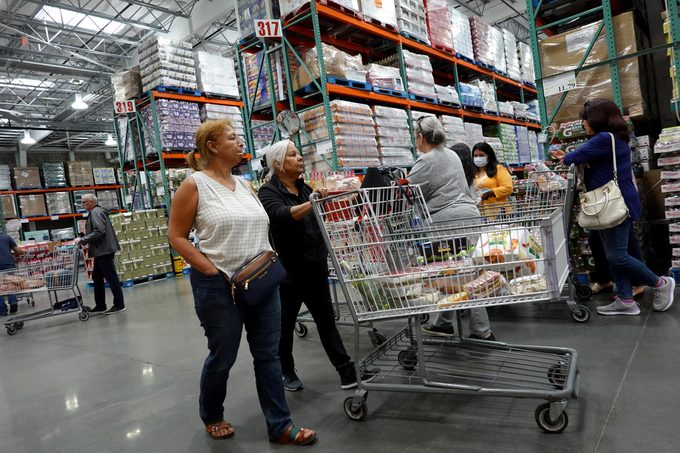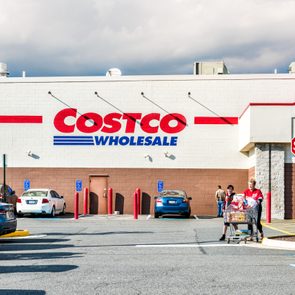Surely you've heard about "The Death Star"?

Costco Code Words Every Shopper Should Know—One Lets You Know It’s Time to Stock Up on a Favorite

Regular Costco shoppers are a savvy bunch, knowing exactly how to wheel around the warehouse club and breeze through checkout in record time. They reflexively reach for Costco’s infamous $4.99 rotisserie chicken and avoid certain Kirkland bread. But sometimes we’re so in the zone we barely notice the code words being shared around us.
Maybe you’ve overheard “go-back” or “The Death Star” in passing, but is that a directive to move backward and a conversation about Star Wars? Who’s to say? You have bulk paper towels to buy and the Costco food court to hit. Priorities, right?
So without further ado, we’ll explain some Costco code words so you can fully immerse yourself in that warehouse club culture.
Get Reader’s Digest’s Read Up newsletter for more shopping, humor, travel, tech and fun facts all week long.
What are the Costco code words?

See if any of these sound familiar: go-backs, the fence, showtime ready. Yes? No? Some you may have heard at other retailers, but others are distinctly Costco.
Go-backs
If you’ve ever worked in retail, you’ve likely heard the term “go-backs” at some point.
“Go-backs are pieces of merchandise left behind at the checkout or in the store that the staff return to their respective shelves,” says Shalvi Singh, a senior product manager for Amazon AI whose job it is to research retail codewords for Amazon Retail. “Shoppers might hear staff say ‘I need to handle go-backs’ while watching employees push carts filled with forgotten go-back merchandise.”
The fence
Ever notice the rather imposing metal fence near your local Costco’s entrance? Yes, it’s referred to as “the fence,” and every location has one, dating back to the days when the retailer was known as Price Club.
“It’s a seasonal high-traffic location for goods such as holiday decorations and pool items,” Singh says.
The Death Star
This one might make you giggle, because once you see it, you can’t unsee it. “An asterisk (*) on price tags means discontinued,” Singh says. “Shoppers should look for these tags to gather unsold products such as clothes that are commonly discounted. The term originated from fans comparing Costco’s efficiency to the Star Wars station.”
However, if you see the Costco Death Star on a beloved item, grab it while you can, because the star also means that product is likely either being discontinued or is only in stores for a limited time and won’t be restocked once it sells out.
Showtime ready
According to Singh, no formal term for this really exists, however it can be used to refer to opening shifts during which employees are tidying aisles and readying the store for customers. “Elsewhere this is more commonly called ‘morning merch,'” she says.
Action alley
No, you aren’t about to enter into a Jason Stratham movie, though it may feel like The Hunger Games if the deals are hot. Action alley is “an aisle that traverses the entire store, containing constantly updated items on sale, such as televisions and seasonal pieces,” Singh explains.
DNI
Simply put, DNI stands for “Do Not Inventory.” You’re more likely to see this written on a box or label as opposed to being spoken between employees. But the acronym is to mark products that need to be returned to vendors, like stale snacks.
Code 99
This is one you hope to never hear in any store, because Code 99 typically means something is afoot. “It refers to a safety emergency, requesting all hands on deck for a security situation,” Singh says. That could be a lost child or a request for security backup to aid an employee who is tending to the issue.
RELATED:
- Here’s Why Aldi’s Cashiers Stay Seated Behind the Cash Register
- New Report: More Americans Are Doing This to Pay for Groceries. Here’s Why Experts Are Concerned
- Here’s Why You Should Skip Precut Fruit Trays at Costco
About the expert
|
Why trust us
At Reader’s Digest, we’re committed to producing high-quality content by writers with expertise and experience in their field in consultation with relevant, qualified experts. We rely on reputable primary sources, including government and professional organizations and academic institutions as well as our writers’ personal experiences where appropriate. We verify all facts and data, back them with credible sourcing and revisit them over time to ensure they remain accurate and up to date. Read more about our team, our contributors and our editorial policies.
Source:
- Shalvi Singh, senior product manager at Amazon AI and founder of Healthengine.us, an AI-driven detection engine for polycystic ovary syndrome



